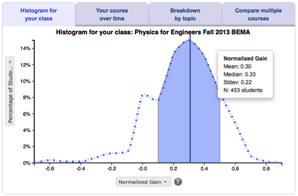Developed by Andrew Mason and Chandralekha Singh
| Purpose | To measure students’ attitudes and approaches to problem-solving at the introductory and graduate level. |
|---|---|
| Format | Pre/post, Multiple-choice, Agree/disagree |
| Duration | 15 min |
| Focus | Beliefs / Attitudes (problem-solving) |
| Level | Graduate, Upper-level, Intermediate, Intro college |
Sample questions from the AAPS:
I usually draw pictures and/or diagrams even if there is no partial credit for drawing them.
A) Strongly Agree
B) Agree Somewhat
C) Neutral or Don't Know
D) Disagree Somewhat
E) Strongly Disagree
Suppose you are given two problems. One problem is about a block sliding down an inclined plane with no friction present. The other problem is about a person swinging on a rope. Air resistance is negligible. You are told that both problems can be solved using the concept of conservation of mechanical energy of the system. Which one of the following statements do you MOST agree with? (Choose only one answer.)
A) The two problems can be solved using very similar methods.
B) The two problems can be solved using somewhat similar methods.
C) The two problems must be solved using somewhat different methods.
D) The two problems must be solved using very different methods.
E) There is not enough information given to know how the problems will be solved.
more details
This is the highest level of research validation, corresponding to all seven of the validation categories below.
Research Validation Summary
Based on Research Into:
- Student thinking
Studied Using:
- Student interviews
- Expert review
- Appropriate statistical analysis
Research Conducted:
- At multiple institutions
- By multiple research groups
- Peer-reviewed publication
Sixteen of the agree/disagree 5-point Likert scale AAPS questions were taken from the APSS, while the other 17 questions were created by the test developers, tested in student interviews and reviewed by experts. The AAPS questions were then tested with 16 graduate students, who also gave verbal feedback on the questions. The AAPS was modified and tested with 24 additional graduate students, of whom some gave verbal and written feedback. The APSS was subsequently tested with over 200 first-semester algebra-based physics students, over 150 second-semester algebra-based physics students, over 100 first semester calculus-based physics students and over 40 second-semester calculus-based course physics students. In addition, the AAPS was given to over 30 students in an introductory astronomy course. Finally, the survey was given to 12 physics faculty who had taught introductory physics recently. Overall, the AAPS has been given to over 600 students and the results published in two peer-reviewed papers.
References
- N. Balta and M. Asikainen, Introductory students’ attitudes and approaches to Physics problem solving: Major, achievement level and gender differences, J. Technol. Sci. Educ. 9 (3), 378 (2019).
- N. Balta, A. Mason, and C. Singh, Surveying Turkish high school and university students’ attitudes and approaches to physics problem solving, Phys. Rev. Phys. Educ. Res. 12 (010129), (2016).
- M. Good, A. Maries, and C. Singh, Impact of traditional or evidence-based active-engagement instruction on introductory female and male students’ attitudes and approaches to physics problem solving, Phys. Rev. Phys. Educ. Res. 15 (2), 020129 (2019).
- A. Mason and C. Singh, Surveying graduate students' attitudes and approaches to problem solving, Phys. Rev. ST Phys. Educ. Res. 6 (2), 020124 (2010).
- A. Mason and C. Singh, Surveying college introductory physics students’ attitudes and approaches to problem solving, Eur. J. Phys. 37 (5), 055704 (2016).
- S. Rakkapao and S. Prasitpong, Use of model analysis to analyse Thai students’ attitudes and approaches to physics problem solving, Eur. J. Phys. 39 (2), 025707 (2017).
- C. Singh and A. Mason, Physics Graduate Students’ Attitudes and Approaches to Problem Solving, presented at the Physics Education Research Conference 2009, Ann Arbor, Michigan, 2009.
PhysPort provides translations of assessments as a service to our users, but does not endorse the accuracy or validity of translations. Assessments validated for one language and culture may not be valid for other languages and cultures.
| Language | Translator(s) | |
|---|---|---|
| French | Olivier Alibart and Frédéric Blanc | |
| Indonesian | Tria Wury Anjani | |
| Portuguese | Raúl Montagne | |
| Turkish | Nuri Balta and Muharrem Duran |
If you know of a translation that we don't have yet, or if you would like to translate this assessment, please contact us!
Download the AAPS answer key.
Score the AAPS on the PhysPort Data Explorer
With one click, you get a comprehensive analysis of your results. You can:
- Examine your most recent results
- Chart your progress over time
- Breakdown any assessment by question or cluster
- Compare between courses
| Typical Results | ||||||||||||||
|---|---|---|---|---|---|---|---|---|---|---|---|---|---|---|
Table 1 from Mason and Singh 2010. “Intro” and “Self” with Graduate students implies problem solving in “introductory physics” and “graduate-level physics courses” respectively.
|
The latest version of the AAPS, released in 2009, is Version 1.






